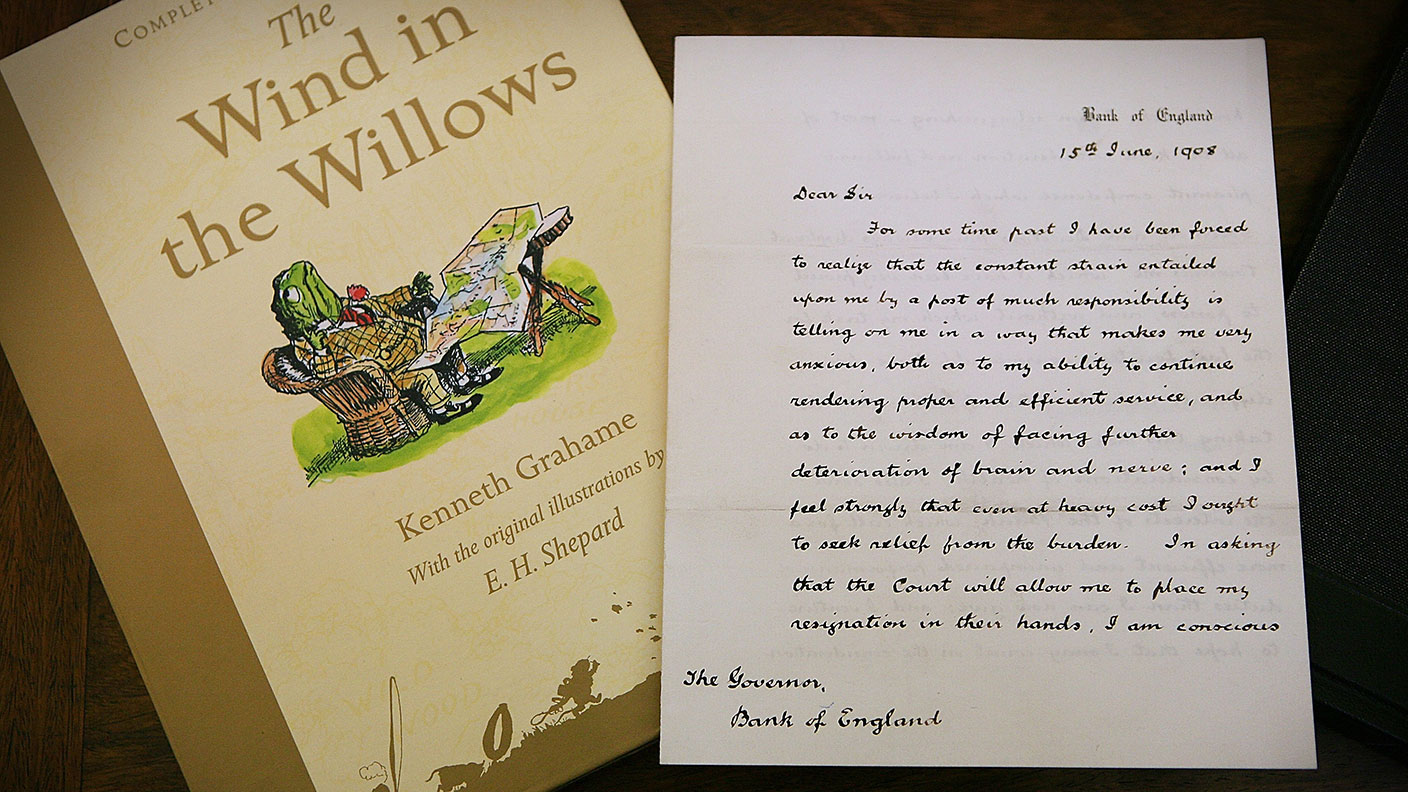8 October 1908: The Wind in the Willows is first published
After being rejected at first, the popular children's classic The Wind in the Willows was first published on this day in 1908.


If you ever need proof that central bankers aren't all completely useless, look to Kenneth Grahame. The author of The Wind in the Willows – one of the most beloved of children's stories – spent almost 30 years toiling away at the Bank of England.
After joining the Old Lady of Threadneedle Street in 1879, Grahame rose up through the ranks to retire in 1908 in the senior position of company secretary. And he could count himself fortunate to do so. Back in 1903, a gunman had entered the Bank looking for the governor. As luck would have it, the governor was out, and the would-be assassin made do with Grahame. Miraculously, Grahame escaped unhurt and would live to see his riverbank tale of Ratty, Mole, Badger and Toad published.
Losing no time after leaving the Bank of England (which it has been said he did under a bit of a cloud), Grahame turned his thoughts to happier times spent messing about by the banks of the River Thames in Berkshire as a child.
MoneyWeek
Subscribe to MoneyWeek today and get your first six magazine issues absolutely FREE

Sign up to Money Morning
Don't miss the latest investment and personal finances news, market analysis, plus money-saving tips with our free twice-daily newsletter
Don't miss the latest investment and personal finances news, market analysis, plus money-saving tips with our free twice-daily newsletter
It's likely these fond childhood memories stood out all the more, considering Grahame had been sent away to live with his grandmother. His father in Scotland was a lapsed alcoholic, while his mother had succumbed to scarlet fever. But down by the riverbank, the young Kenneth Grahame found happiness. Later, as an adult, Grahame drew on these same memories to invent bedtime stories for his sickly young son, Alastair.
These stories evolved into The Wind in the Willows. Considering how popular the story is today, it's hard to imagine that nobody at first wanted to publish the book. But Methuen and Co took a chance, and on 8 October 1908, The Wind in the Willows was first published, in the year of Grahame's retirement from the Bank.
It was widely panned from the outset. One critic wrote that it would “win no credence from the best authorities on biology”, completely missing the point of Grahame's anthropomorphic characters. But Grahame did receive one piece of fan mail from an admirer who carried an awful lot of weight – Theodore Roosevelt. The US president said he had read and re-read the book until the riverside residents were like “old friends”. He even popped over to Britain for a visit. The book soon became a huge success – so much so, in fact, that it's never been out of print.
And if you do have an old, first edition knocking about, it could be worth something. In 2010, a first edition dedicated to Foy Felicia Quiller Couch, the daughter of one of Grahame's friends, thought to be the inspiration for Ratty, sold for £32,400 at Bonhams. Time to check the attic.
Get the latest financial news, insights and expert analysis from our award-winning MoneyWeek team, to help you understand what really matters when it comes to your finances.

-
 ‘Why I have ditched my Help to Buy ISA for cash savings and the stock market’
‘Why I have ditched my Help to Buy ISA for cash savings and the stock market’Without the 25% bonus, my Help to Buy ISA is effectively redundant, says MoneyWeek writer Sam Walker.
-
 Is your inheritance tax allowance cut if you sell to downsize or sell your home to pay for care?
Is your inheritance tax allowance cut if you sell to downsize or sell your home to pay for care?Downsizing relief is a little-known benefit that could save your loved ones tens of thousands of pounds in inheritance tax after you’ve died.
-
 31 August 1957: the Federation of Malaya declares independence from the UK
31 August 1957: the Federation of Malaya declares independence from the UKFeatures On this day in 1957, after ten years of preparation, the Federation of Malaya became an independent nation.
-
 13 April 1960: the first satellite navigation system is launched
13 April 1960: the first satellite navigation system is launchedFeatures On this day in 1960, Nasa sent the Transit 1B satellite into orbit to provide positioning for the US Navy’s fleet of Polaris ballistic missile submarines.
-
 9 April 1838: National Gallery opens in Trafalgar Square
9 April 1838: National Gallery opens in Trafalgar SquareFeatures On this day in 1838, William Wilkins’ new National Gallery building in Trafalgar Square opened to the public.
-
3 March 1962: British Antarctic Territory is created
Features On this day in 1962, Britain formed the British Antarctic Territory administered from the Falkland Islands.
-
10 March 2000: the dotcom bubble peaks
Features Tech mania fanned by the dawning of the internet age inflated the dotcom bubble to maximum extent, on this day in 2000.
-
9 March 1776: Adam Smith publishes 'The Wealth of Nations'
Features On this day in 1776, Adam Smith, the “father of modern economics”, published his hugely influential book The Wealth of Nations.
-
 8 March 1817: the New York Stock Exchange is formed
8 March 1817: the New York Stock Exchange is formedFeatures On this day in 1817, a group of brokers moved out of a New York coffee house to form what would become the biggest stock exchange in the world.
-
7 March 1969: Queen Elizabeth II officially opens the Victoria Line
Features On this day in 1969, Queen Elizabeth II took only her second trip on the tube to officially open the underground’s newest line – the Victoria Line.